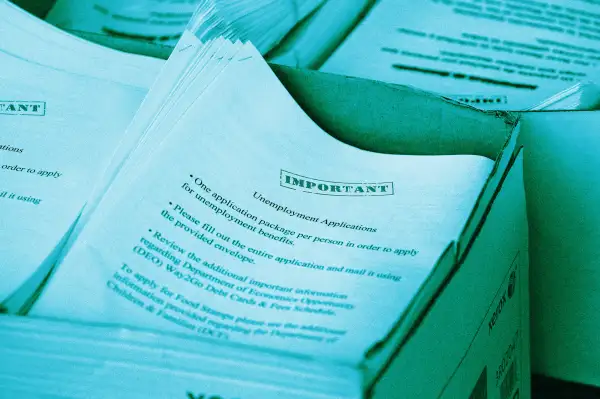New Unemployment Benefits: Who Qualifies and When Payments Start

On Saturday, millions of Americans lost their unemployment benefits as the extended programs included in the CARES Act came to an end.
Luckily, Congress's new relief package — which, in addition to introducing second stimulus checks and money for vaccine distribution, further extends unemployment benefits to out-of-work Americans — was signed by President Donald Trump on Sunday. And not a moment too soon.
While unemployment benefits in most states fail to cover even basic living expenses, without them, unemployed Americans would be hurting more than they already are.
For many people, though, news of the new stimulus package brings up questions of eligibility, timing and more. Here are the answers.
Will I get the same unemployment benefits this time around?
The second coronavirus relief package includes an extra $300 per week — on top of regular state-issued unemployment payments — for every unemployed person (half of the extra benefits people were getting via the CARES Act).
As of Dec. 14, high levels of unemployment in 24 states plus the District of Columbia, Puerto Rico, and the Virgin Islands have triggered federally funded Extended Benefits (EB). If you are currently receiving EB, the new legislation requires recipients to exhaust those funds before returning to Pandemic Emergency Unemployment Compensation (PEUC) assistance. However, EB participants will still receive the additional $300.
What if I'm a freelancer?
This package is more generous for people with a mix of traditional wages (W2s) and self-employed wages (1099s). These workers — which include rideshare drivers and other freelancers who work traditional part-time or full-time jobs at the same time — will get an extra $100 per week on top of the $300 boost.
Many gig economy workers also have traditional jobs — or had one within the last year, says Indivar Dutta-Gupta, co-executive director of the Georgetown Center on Poverty and Inequality. Those people could have gotten higher unemployment benefits under the Pandemic Unemployment Assistance (PUA) but they had to accept the traditional unemployment benefits instead, adds Dutta-Gupta. (If you’re eligible for traditional unemployment insurance, you have to accept that over PUA).
Here’s a specific example: someone working freelance gigs in the theater industry may have made more money that way than the part-time restaurant job they also had, but unemployment benefits from that W2 job disqualified them from collecting any freelance PUA. Under the new law, they'll get an additional $100 if they make at least $5,000 in wages from self-employment.
People who only get paid through 1099 gigs, and receive PUA benefits, are also eligible for the extra $300 per week.
Am I still eligible for unemployment benefits?
Due to delays from the White House, federal extended benefits programs lapsed for an estimated 14 million people after Dec. 26, leaving many to wonder whether they would still be eligible when the new bill passed. The answer is pretty cut and dry: If you are currently unemployed — whether you're a long-term or recent claimant — or become unemployed in 2021, you will be eligible for extra benefits.
"People who have been on unemployment during this period will get all of the additional benefits," says Andrew Stettner, a senior fellow at The Century Foundation. "But it won't be looking back, it will be for people who continue to be unemployed in 2021."
Those who previously experienced joblessness between July 31 and Dec. 27, but have since found work will not receive any retroactive enhancements, even if they're still reeling from the lost income.
How long will these new unemployment benefits last?
The PEUC in the CARES Act provided workers who exhausted their state unemployment benefits with up to 13 more weeks of benefits. The new relief package has extended that to 24 weeks.
Meanwhile, those who don’t qualify for traditional state unemployment benefits could get up to 39 weeks of benefits via the Pandemic Unemployment Assistance program (PUA) in the CARES Act — that has now been bumped up to 50 weeks.
The new relief package includes an extension of both programs to March 14. Workers who haven’t exhausted their benefits will continue to receive benefits until the week of April 5.
The new legislation says that the supplemental $300 weekly unemployment benefit will also end on March 14.
When will the new unemployment checks start arriving?
Millions of American workers lost their jobs seemingly all at once last spring, with the wave of layoffs causing major backlogs for outdated and underfunded state unemployment systems. Many waited weeks, or even months to start receiving enhanced benefits. This time around, wait times are expected to be much less severe — but don't expect instant deposits.
While the PEUC and PUA programs that extended coverage for those experiencing long-term unemployment will likely start back up right away come January 1, Stettner cautions that enhanced benefits may still take a bit longer to get from the feds to state agencies.
"Three to six weeks is likely the range of time it will take to start getting the extra $300 to people," he says.
More from Money:
Second Stimulus Checks: What to Know About the $600 Amount, Eligibility, Payment Timeline and More
Second Round of PPP Loans: Everything We Know About Eligibility, Tax Breaks and More
PSA: You Can Use Your FSA Money to Buy At-Home Coronavirus Tests

